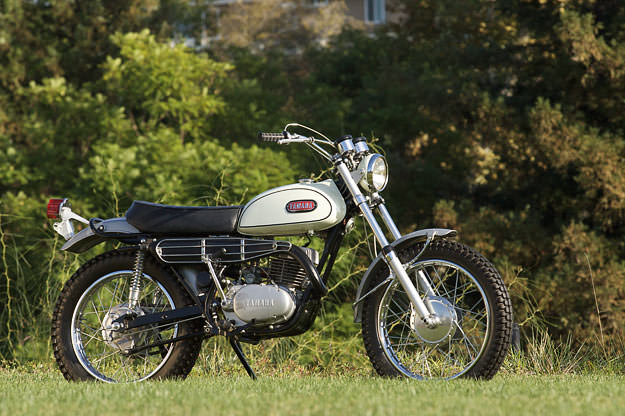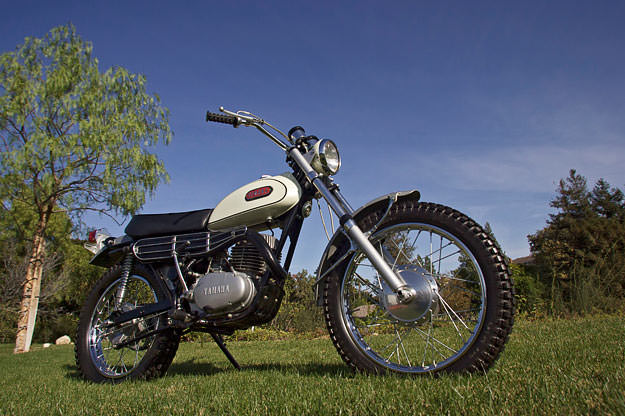
The 1968 DT-1 is more than a contender for Yamaha’s most important motorcycle. It’s a bike that broke things wide open for the entire Japanese motorcycle industry. Words by Mitch Boehm, Editor & Publisher of Moto Retro Illustrated. Photos by Joe Bonnello and Ed Burke archive.
As wild and transformative as the 1960s were, year eight of the decade was a doozie. The Tet Offensive. Assassinations. The White Album’s release. The ascendancy of Nixon. NASA. Police beatings in Chicago. Hippies, LSD and growing disillusionment with the so-called Summer of Love.
Crazy times, for sure.
Motorcycling had its own explosive event that year, though few motorcyclists heard or felt the impact, at least at first. The happening was Yamaha’s introduction of an all-new motorcycle – a street/dirt hybrid built around a 250cc two-stroke single. The motorcycle would not only become a legendary sales and playbike/racing success in short order, but would dramatically alter the motorcycling landscape in this country.
That bike was the DT-1.
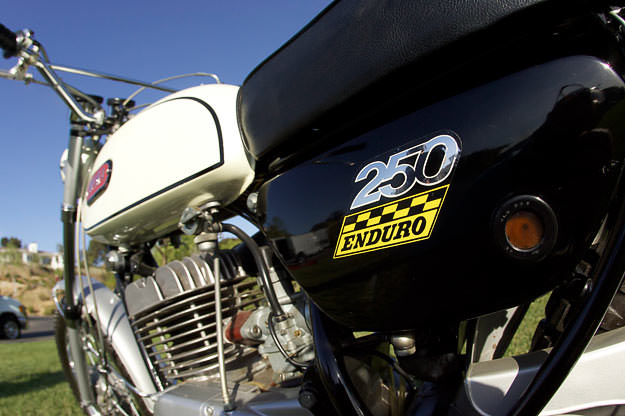
“I remember seeing the DT-1 at the Anaheim show that year,” says longtime industry veteran Tom White, “and I’ll never forget it. It was beautiful, and looked like it could do anything. I could see myself riding it, and all the things I could do on it.”
Karma was with White because, within months, the teenager found himself riding a brand-new, pearl-white DT-1 along California’s coast highway. “I couldn’t believe it,” White remembers. “There I was, riding along, drinking it all in, and at a stoplight a guy pulls next to me and says, ‘What the heck is that?!’ I was in heaven.”
Heaven – a perfect descriptor for the launch of the DT-1, for owners, Yamaha dealers and Yamaha itself.
“Looking back on it,” says longtime Yamaha product-planning guru Ed Burke, who was involved with the DT1’s development as well as bikes such as the legendary 650 Special and V-Max, “it was one of the best examples of a company bringing a model to market in an almost perfectly way. Yamaha did such a great job with the DT-1. The company had wonderful two-stroke technology to tap into. It had great research to guide it, with Japan trusting the U.S. product planners implicitly during development. And what Yamaha engineers came up with was nothing short of a blockbuster motorcycle, one that did everything well – just as the product-planners had scripted it. Enthusiasts loved it. Racers loved it. The aftermarket – which grew substantially because of this motorcycle – loved it. And dealers loved it.”
Yamaha loved it, too, because it was soon selling nearly 50,000 of the things per year.
50,000 units per year, for a single model. That number seems crazy in this day and age, when a model that sells 5000 units is considered a success. But it illustrates perfectly how explosive the motorcycle market was in the late 1960s and early 1970s, when baby boomers were coming of age and discovering the joys of two-wheeled fun thanks in large part to the value, reliability and performance potential of Japanese motorcycles.
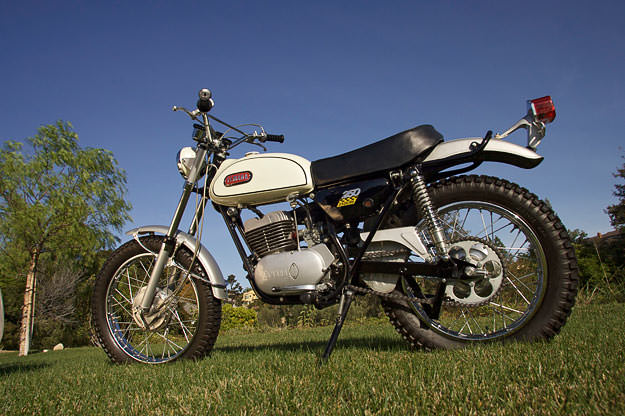
“I was a junior in high school in ’68,” says longtime industry veteran Ken Boyko, who owns five DT-1s today, “and I remember seeing a white DT-1 when they came out. I just stood there sputtering… It was the coolest thing I’d ever seen. To get a 250 would be the ultimate – like riding a Triumph. I rode my bicycle to the shop almost every day, looking, drooling… What a cool motorcycle…”
Motorcycling’s explosive growth in that era resulted from many factors, but none were more influential than the perfect storm of demographics – the baby boom generation – and the availability of reliable, inexpensive and fun motorcycles from Japan.
“Boomers began turning 16 in about 1961,” says Burke, “and millions followed in the next fifteen years.” Some were gearheads and adventure-seekers, folks predestined to dive into motorcycling. Many, however, were mainstreamers, people who needed a bit of a nudge – one provided by good marketing (Honda’s ‘You Meet The Nicest People’ campaign, for instance), various bits of pop culture (the movies The Wild One and On Any Sunday are good examples) and the increasing number of motorcycles on America’s streets and trails.
“Japanese offerings in the U.S. in the early and mid-’60s were primarily smaller bikes,” says Burke. “Yamaha had plenty – small two-stroke streetbikes and some medium-sized ones like the Catalina and Big Bear scrambler. These – and offerings from the other Japanese makers – quickly carved out a reputation for being fun, inexpensive and reliable, and they quickly brought motorcycling to a wider audience.”
By the latter 1960s that wider audience was ready; ready for larger, more advanced motorcycles (which it’d get in the form of Honda’s CB750 and Kawasaki’s Mach III in ’69) and also for more dirt-worthy machines than the street-oriented twin- and single-cylinder ‘scramblers’ being offered. Harder-core enthusiasts were all over the off-road machines from the European brands – Husqvarna, Maico, Bultaco, OSSA, CZ, etc. – but mainstreamers wanted (and needed) something less expensive, more reliable and easier to get parts for.
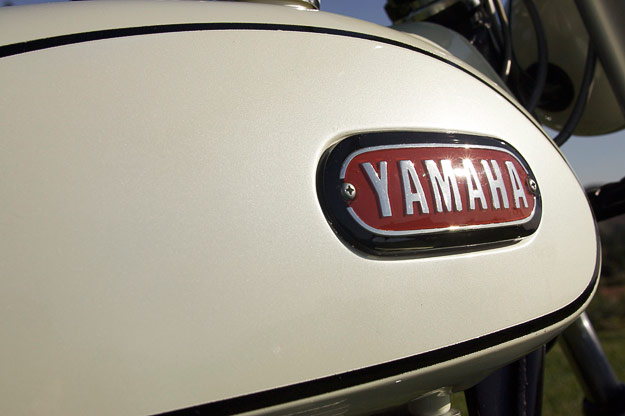
Enter the DT-1, which debuted in early 1968 and which surely helped fuel the huge sales spike seen from ’68 to the all-time peak sales year of 1973, when the first fuel crisis took some of the air out of the balloon. The sales numbers during that spike were – and are – staggering. “Folks began being a little more performance-oriented at the time,” says Burke, “and the DT-1 hit them right where they live. It was a decent streetbike, and a pretty good off-road bike and racer, too, so it gave them a lot of options. It was fast and really good looking, and it didn’t cost much – about $750 or so back then.” The thing sold like gangbusters immediately, and by 1971 Yamaha had expanded the line to include a 90 (HT-1) 125 (AT-1), 175 (CT-1) and 360 (RT-1), and there were off-road/MX variants of several of those, including a 60cc version called the JT-1 Mini Enduro. Yamaha sold a bazillion of the things. “Looking back on it,” adds Burke, “the DT-1 just might be Yamaha’s most important motorcycle ever.”
That’s a bold statement, but the DT-1 is arguably one of the Japanese motorcycle industry’s most important machines. By being a jack-of-all-trades, handsomely-yet-aggressively styled, cheap, and by providing serious on- and off-road performance, the DT-1 helped spread motorcycling to the masses – enthusiasts and newbies alike. It did more than make Yamaha a household name; it pushed up an entire industry by singlehandedly creating the serious dual-purpose niche, a category in which all the Japanese companies would eventually find massive success.
“The DT-1,” says longtime vintage restorer and enthusiast Rick Doughty, “was designed to fill the dual-purpose/enduro segment and provide competition for Honda’s 250 Scrambler. While well received, the Honda was a heavy, glorified streetbike. Its classy, dirt-oriented styling was its strongest feature, and Yamaha knew it, so they set out to build what would become Japan’s first true dirt/dual-purpose machine. In the process Yamaha reinvented the category and built a bike that became the foundation for many a great racebike, not the least of which was the ground-breaking YZ250.”
Yamaha in the early 1960s was a company on the move. After kick-starting motorcycle production in Japan in ’53 with its 125cc YA-1, the company began selling bikes in the U.S. in 1958, first under the Cooper Motors umbrella and, two years later, through its own dealers. Yamaha’s two-stroke bikes got better every year, with hot rods such as the ’63 250cc Ascot Scrambler and the company’s trick Autolube system of ’65 doing plenty to buttress Yamaha’s brand and reputation.
It was under these market conditions – rapidly increasing sales for Japanese bikes (including the popular ‘scramblers’) and off-road riding and racing gaining in popularity – that Yamaha began work on the DT-1. The nut of the idea came from some of the off-road enthusiasts working for Yamaha at the time – desert riders, racers, dealers and all-around dirtbike enthusiasts.
“The thinking,” says Burke, “was to make the bike simple and durable and competent – a true do-it-all machine. We knew what would work, really. We had great research, and very good people in all phases – sales, engineering, research, product planning, testing, and some very savvy dealers, too.
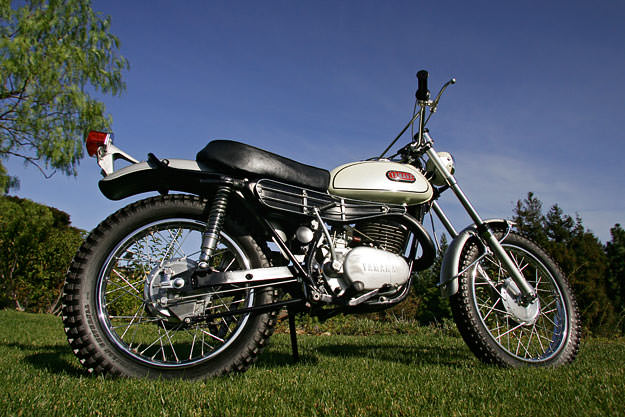
Jack Hoel, son of J.C. ‘Pappy’ Hoel of Sturgis fame (Hoel Sr. basically started the famous Sturgis Rally) and a Yamaha product-planner, was one. “Pappy owned the Indian/Yamaha dealer in Sturgis at the time,” says ex-Yamaha man Tom Berkley. “Yamaha built road bikes and was dabbling in styling changes to make them look like off-road models, like some of the other manufacturers were doing. They were called ‘scramblers’ at the time, and Jack helped convince the factory to rethink the direction. His inspiration came from the true enduro bikes from Montesa and Bultaco and the like, and some of the desert bikes his friend and Yamaha colleague Dave Holeman was riding.” Hoel hit the nail on the head with a serious dual-purpose concept… and the rest, as they say, is history.
“Guys like Hoel, Tom Clark, Terry Tiernan, Sam Corona and others were key,” says Burke. “They were all enthusiasts… racers, riders and fans. I wish I could take credit for the bike, but I wasn’t involved nearly as much as these guys.”
The key was the emerging dual-purpose market, which wasn’t overly large or mature at the time, but which showed promise. “Yamaha felt that market could be huge,” Burke says. “The bike had to be good enough on the street, but really good off-road. It had to be reliable, and have the potential for even more power, which is where our GYT (Genuine Yamaha Tuning) kits came in. Our engineers were really savvy with two-stroke technology. We felt that if we could get the combination of streetability, off-road performance and ballsy looks just right, we’d do well. The bike had to blend the power, fun, excitement and adventure the European dirtbikes had going for them in a reliable package with a low purchase price.
The team began by doing plenty of market research to get a feel for what was selling, what bikes and designs resonated with the public, and where the buyers of all those ‘little’ Japanese bikes were likely to go as their motorcycling tastes matured. The team also bought and tested competitive machinery, including Hodakas and some of the more successful dirt-oriented Euro bikes.
“We did most of the testing and development here,” says Burke. “Yamaha Japan was smart to trust the guys on the U.S. side. Watching the process from my east-coast sales manager position, I was impressed, and being pretty dirt-oriented, it was nice to be involved.”
Yamaha followed a fairly standard development process with the DT-1. Sketches were done early-on in Japan by stylists to determine shapes and an overall look, while factory engineers and testers began working on dynamic prototypes, which were wholly unattractive but hugely important, as they determined things such as frame geometry, engine placement and loads of other vital measurements.
Meanwhile, engineers developed a piston-port 246cc two-stroke single incorporating Yamaha’s then-new Autolube oil-injection system, making premix a thing of the past. Some reports say the DT-1 engine was a revised version of a streetbike engine designed in ’65/’66 that never made it to production, though the technical changes made to the powerplant make it almost a moot point. Engineers concentrated on blessing the engine with a friendly demeanor and plenty of power spread over a wide range – quite different from how a more powerful streetbike engine would behave. Prototype versions of this new engine were run on dynos, housed and tested in early prototype chassis, and slowly but surely engineers got what they wanted: decent horsepower (roughly 23 at the crank), broad power and, most importantly, hammer-like reliability.
As dynamic prototypes inched closer to the bike’s final specification in mid-1967, Yamaha began doing substantial testing in the U.S. in a number of environments, from woods to desert to on-road. Much of the testing was handled by Yamaha testers and product development folks, but a portion was also done by dealers and racers in the So Cal area.
Technically, the DT-1 wasn’t revolutionary. Piston-port two-stroke single, five speeds, steel tube frame, drum brakes, standard instrumentation, etc. The bike’s brilliance stemmed from the way Yamaha integrated all of it – its styling and functional and dynamic excellence.
The DT1’s debut at Yamaha’s dealer meetings in late 1967 and early ’68 created a huge stir, dealers signing up for as many bikes as they could get and enthusiast magazines spreading the word nationally about the new bike over the coming months.
“The DT-1 handles infinitely better than the usual hybrid street-scrambler,” wrote Cycle in its May, 1968 issue. “Considering he number of genuine motorcycle enthusiasts at Yamaha International in Los Angeles, it was inevitable the finished product should be right on target – and it certainly is.”
Cycle Guide went even further in its June, 1968 issue, predicting “nothing but success for the DT-1 enduro. Yamaha has hit on the right combination of street and dirt machine, and in fact are building their whole ’68 sales program on the dual-nature motorcycle. When they produce a bike like the [DT-1] all we can do is wish them luck, though we don’t think they’ll need it.”
“I started at Yamaha in January of 1968,” says Berkley. “The DT-1 was just going into production, and was featured at the dealer meetings shortly thereafter. In June, as the DT-1s were being delivered to dealers, I held seminars from Orlando to Seattle to introduce the bike’s technical details to dealers.”
Dealers were understandably excited about receiving crates of DT-1s, and in short order were selling ’em by the handful. The bike appealed to a wide range of riders – dirt-oriented enthusiasts, for sure, who rode and raced it from western deserts to eastern woods. But the DT-1 also caught the attention of less-grizzled motorcyclists, a newer group of motorcyclists who’d gotten hooked by the two-wheeled bug during the ’60s and who were after a simpler form of excitement than the racers and hard-core types lived on.
“The DT-1 was one bike that blew mainstream motorcycling wide open’,” says Jack Seaver, longtime enthusiast, racer and Yamaha dealership employee during the early 1970s. “It created a big buzz and appealed to a wide range of riders. Experienced enthusiasts, for sure, but also a more mainstream rider who was hooked by the bike’s good looks and all-around abilities. These guys wanted the bike’s perceived off-road clout even though most never even took the thing off the pavement.”
But many did, as off-road racing was literally exploding all over the country, from the east coast woods to the western deserts. “It was crazy in the late ’60s on the racing front,” says Burke.” If you were in Ohio, for instance, you could do several enduros per weekend.”

“The first real racing with the DT-1,” says Berkley, “was in the desert by Ken and Norm of K&N Yamaha in Riverside. Dick Allen, a dealer in Newhall, also put one on the desert right away. Ken and Norm came into the shop at Yamaha on Monday with the [DT-1’s] paper air-filter, which was clogged by dirt. They’d done well until their engine choked for a lack of air, and ended up inventing the original oiled foam/screen K&N filter.
“Mark Blackwell was probably one of the first riders in the U.S. to race motocross on a DT-1,” adds Berkley. “All of us wannabes bought DT-1s to play in the desert – El Mirage, etc.”
“Compared to bikes like the Honda Scrambler,” says Doughty, “the DT-1 was lightweight, powerful and handled like a dirtbike you could ride on the street. It wasn’t as target-specific as the euro-motocross or enduro machines, but certainly good enough to enthuse a huge number of veteran and first-time riders to take the plunge. That helped create an equally huge aftermarket business for parts and pieces to modify the DT-1 into a motocrosser, dirt tracker, TT bike or desert racer. ‘Jack of all trades’ and master of none is probably the most fitting epitaph for the first real mainstream dirtbike from Japan.”
“I wasn’t involved in the DT-1’s development,” says Gary Jones, multi-time national motocross champion. “But once my Dad got his hands on one, we got pretty excited. In the desert, on the dirt tracks, we rode ’em and raced ’em right off the bat; they had potential right out of the box. Of course, we started modifying stuff right away – pipes, porting, frames, carburetors, etc. We started to get serious about motocross in ’69. We ended up making big changes – we lowered the engine, modified the motor even more, changed suspension, etc. We even sold kits for these mods, as you couldn’t buy this stuff back in the day. There was no FMF or Pro Circuit back then – just some smaller companies that would get bigger in a hurry. We won championships in ’71 and ’72, and I guess we were at the forefront of the aftermarket wave we see today.”
In many ways, the DT-1 turbocharged an aftermarket industry that would literally explode in size during the 1970s and service all manner of motorcycle genres, from motocrossers to roadracers and everything in between.
“The DT-1 wasn’t a great racer in stock condition,” says Tom White, “but with the right mods it was plenty good. Yamaha was smart to offer the GYT kit. [Keith] Mashburn and [Freddie] Edwards rode the heck out of them on the dirtracks. But the bike really jumpstarted the aftermarket; it was easy to build parts that made it better for off-road riding and racing. But the real credit goes to the guys at Yamaha; they did such a good job with the basic package. I remember my first race on mine; I rode it to Huntington Beach Cycle Park, took the lights off, pulled the mirrors, and raced a TT there – then rode it home! It had a GYT kit and a J&R silencer. Great memories!”
Retail sales from ’68 on were simply insane. Dealers were riding a wave of enthusiasm and excitement fueled by the combination of baby-boomer numbers and the ever-increasing numbers of inexpensive and hugely functional motorcycles… and the DT-1 in many ways led the charge.
“Some dealers were selling a thousand DT-1s per year,” says Burke. “Amazing. One was in Sissonville, West Virginia. Another, on the Ohio border, was Don Tate’s place.”
But what’s doubly amazing is the effect the bike bad on the industry as a whole. Within a few years of the DT-1’s release, Yamaha offered an entire line of dual-purpose bikes, from 60 to 360cc. The other Japanese manufacturers followed suit, and soon the streets, trails and tracks of American were full of the things, buzzing around and putting huge smiles on the faces of their owners. In many ways, dual-purpose bikes opened the floodgates to the industry’s phenomenal growth of the early ’70s by appealing to a more mainstream rider, and introducing many thousands of relative newbies to the sport of motorcycling.
All of which means it’s pretty much impossible to overestimate the significance of the DT-1, or the effect it had on the industry. Its technology, timing, performance and ridability were all shockingly spot-on. And I’d find out how true all this was a week or two before this issue went to press when Cobra USA’s Ken Boyko offered me a chance to ride one of his DT-1s. I’d planned to simply ride the thing around the block a few times, but Boyko had a more involved test-ride planned. Boyko, his son Dustin, Cobra special project manager and fellow vintage expert Denny Berg and I took two of Boyko’s DT-1s and a pair of his 360cc RT-1s on a 15-mile lunch run along Pacific Coast Highway on a sunny Friday afternoon and had a serious blast. The orange, ’70-spec DT-1 I rode was light, peppy, reasonably comfortable and possessed the sort of dirtbike-with-lights mentality I always imagined these bikes would have. The burbling 2-stroke exhaust note, the smoky take-offs, the pop-pop-pop while decelerating for stoplights and the visceral, chunky feel of the controls and shifter put me solidly back in time. I was only eight years old in 1970, but after that ride I have a pretty good feel for what thousands upon thousands of motorcyclists experienced during the DT-1’s reign.
“The Yamaha DT-1 was not the world’s first dual-purpose bike,” says ex-Cycle World Editor David Edwards. “But do you remember the Bultaco El Montadero or the Montesa Scorpion? You do not. And if you recall the BSA 441 Victor (a.k.a. “Victim”) at all, it’s probably because one of the bastards kicked back and broke your ol’ man’s ankle. Nope, what the DT1 was, was the world’s first practical, affordable, viable dual-purpose bike. The fact its Autolube system meant you never again had to mix two-stroke oil with the gas (Hello, Spain…) was just a bonus. The DT1 spawned imitators by the dozens; within a few years, 60% of new-bike sales in the U.S. were dual-purpose. It also gave birth to the off-road aftermarket industry that’s still with us today, as vendors created suspension kits, expansion chambers, hop-up parts, etc.
“So, the world’s first dual-purpose bike? No. The most important dual-purpose bike? No doubt.”
Can’t put it much better than that.
[Thanks to Mitch Boehm. Get your subscription to Moto Retro Illustrated here.]
